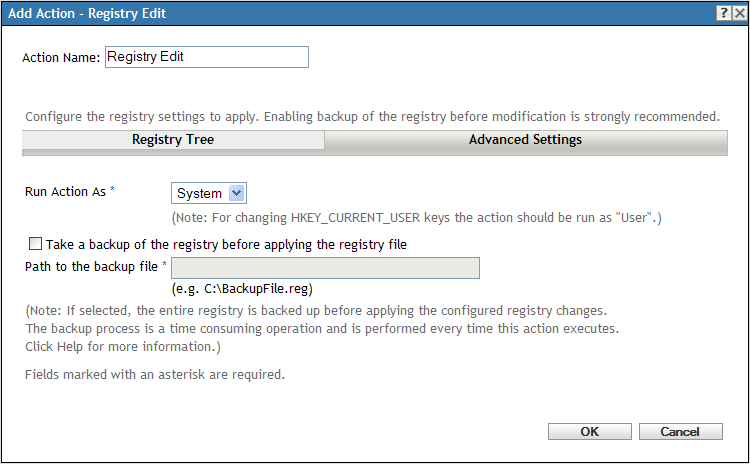E.25 Action - Registry Edit
The Action - Registry Edit dialog box lets you configure the registry settings to apply. We recommend that you back up the registry before applying the specified registry settings, and ensure that the registry is properly formatted and well tested.
Click the tab to select hives in the tree to which you want to add values and keys, rename or remove sections, or import a registry file. Click the tab to specify how you want the action to run (as system or user) and to back up the registry file before applying the modified registry file.
You access this dialog box by using the following methods:
-
As part of the process of creating a Directive bundle by using the bundle category. For more information, see Section 2.1, Creating Directive Bundles.
-
In ZENworks Control Center, click the tab, click the underlined link of a bundle in the column of the list, click the tab, click one of the action set tabs (Install, Launch, Verify, Uninstall, Terminate, or Preboot), click the drop-down list, then select an available action.
The following sections contain additional information:
E.25.1 Registry Tree
The Registry Tree page lets you select hives in the tree to which you want to add values and keys, rename or remove sections, or import a registry file.
Figure E-27 Action - Registry Edit Dialog Box: Registry Tree Page

The following table lists the tasks you can perform to manage registry tree changes.
|
Task |
Steps |
|---|---|
|
Add a registry key |
|
|
Add a registry value |
|
|
Rename an entry |
|
|
Remove an entry |
|
|
Import the contents of a registry file |
|
|
Search for a registry value name, registry key, or both. |
|
E.25.2 Advanced Settings
The Advanced Settings page lets you configure the registry settings to apply.
Figure E-28 Action - Registry Edit Dialog Box: Advanced Settings Page

Run Action As: Specify how you want the action to run:
-
System: The action is run under the Local System user and inherits Administrator-level credentials. For example, the action has full rights to the HKEY_LOCAL_MACHINE hive.
Select the option to enable the changes to be made in the user’s hive instead of the DEFAULT hive of HKEY_USERS.
-
User: The registry file is applied using the logged-in user’s credentials. For example, the action has the same rights to the registry and the file system as the logged-in user. If you are changing keys in the HKEY_CURRENT_USER hive, you must run the action as User. Depending on the rights assigned to the user, the action might or might not have rights to the HKEY_LOCAL_MACHINE hive. If you select , the user must be logged in to the device or the action fails.
Take a Backup of the Registry Before Applying the Registry File: Select the check box, then specify the path to the backup file, for example, c:\BackupFile.reg.
If you select this option, the entire registry is backed up before importing the configured registry file. The backup process is performed every time this action executes. This can be a time-consuming operation and the backup file can be large.
Before you edit the registry, export the keys in the registry that you plan to edit, or back up the entire registry by selecting this option. If a problem occurs, you can then restore the registry to its previous state.